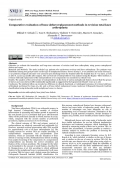Objective: to evaluate the immediate and long-term outcomes of revision total knee arthroplasty using porous metaphyseal sleeves and cones.
Materials and Methods. The study included 134 patients who underwent revision total knee arthroplasty. The patients were distributed among two groups based on the type of metaphyseal fixator: sleeves (Group I, n=97 patients) and cones (Group II, n=37 patients). Surgical outcomes were assessed upon discharge from the hospital (after the hospital stay of 7-12 days), as well as after 6, 12 and 24 months after surgery. The survival rate of endoprostheses was analyzed using the Kaplan–Meier method. A revision with total replacement of the endoprosthesis or its components was considered a critical event.
Results. The analysis of the survival rate of endoprostheses in the form of various metaphyseal fixators showed that the groups of sleeves and cones did not differ statistically significantly as suggested by the logrank test (Mantel–Cox): p=0.108. Conclusion. The midterm follow-up revealed no difference in clinical, functional, or radiological outcomes of revision total knee arthroplasty performed for types 2A, 2B, and 3 of bone defect replacement (sensu Anderson Orthopaedic Research Institute classification) using trabecular metal metaphyseal cones vs. sleeves.
